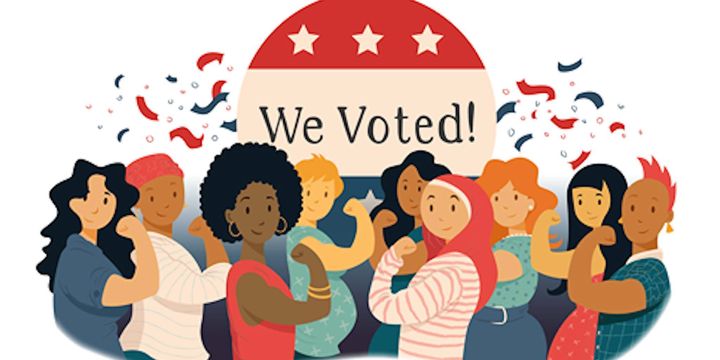The danger of a single narrow narrative for civil rights policy or legislation such as Title IX and suffrage expansion is that it diminishes the power that it can hold for millions of individuals.
Last year on July 26th, a major political party officially nominated a woman as their presidential candidate for the first time. Hillary Clinton, dressed in all white (a nod to the suffrage movement), accepted the nomination and made history. Accepting the nomination was far from the first step in women’s liberation. Rather it was a celebration of a long and calculated movement of determined women. And then the 2016 election happened.
Clinton’s nod to the suffragists was a reminder of the history, pain, and work they put into passing the 19th amendment that must not be forgotten or glazed over as simply ”the right to vote”. Similar to Title IX being seen as the “sports law”, the 19th amendment and the Education Amendments Act had broader goals for women and for society. Both laws represent so much more than they appear and learning more about their purpose and true intent can help lead us to further progress towards women’s equality.
In 1848, the suffrage movement began with Elizabeth Cady Stanton and Lucretia Mott organizing the Seneca Falls Convention, inspired by their trip to an Anti-Slavery Convention. This was a coming together and a call for all women’s civil rights, even beyond voting. The official document, the Declaration of Sentiments, called for expansion and recognition of equal rights to women, including suffrage. Modeled after the Declaration of Independences, it shares qualities of the Equal Rights Amendment. The document stated that a woman was man’s equal, called for expansion of educational opportunities, and inclusion of women to all career fields. Ironically, during the convention, women’s suffrage was the only resolve that was not unanimously passed.
In the context of the legislative process and societal norms, activists and suffragists used the energy from this convention as a catalyst to lobby states to ratify a woman’s right to vote, which was a significant step in women’s emancipation. Twenty-one states had ratified this policy before the federal government passed the 19th Amendment for women’s suffrage in 1920. The 19th Amendment simply says: “the right of citizens of the United States to vote shall not be denied or abridged by the United States or by any state on account of sex. Congress shall have power to enforce this article by appropriate legislation.”
Though its meaning clear, this amendment did not allow for all women to vote. It wasn’t until 1947 that Native American women got the right to vote, in 1952 the policy began including Asian women, and finally, in 1965, the Voting Rights Act gave Black women the right vote.

FACEBOOK'S WOMEN'S EQUALITY DAY IMAGE LAST YEAR. A NUMBER OF THESE WOMEN HOWEVER DID NOT HAVE THE RIGHT WITH THE 19TH AMENDMENT.
As Evette Dionne noted in her piece “Women’s Suffrage Leaders Left Out Black Women” for Teen Vogue, “Black women publicly fought for their right to vote, and often. In her 1867 speech at the American Equal Rights Association, Sojourner Truth argued that giving black men the right to vote without affording black women the same right only promoted black men's dominance.” Acknowledging the full story and history of the 19th Amendment helps us see how much we have to do to achieve racial and gender justice collectively.
Much like the 19th Amendment and voting, Title IX of the Education Amendments Act, goes beyond the sports label that it has been given. Passed in 1972, Title IX prohibits sex based discrimination in educational settings. While this expanded opportunities for athletics, it also prohibits discrimination against pregnant/parenting students, transgender and gender non-conforming individuals, sexual harassment, and inequitable access to science, technology, engineering, and math (STEM) programs and resources.
In June, Title IX celebrated its 45th anniversary, but only a few years ago did the U.S. Office for Civil Rights (OCR) focus on the STEM pillar or respond to the pleas of rape victims speaking up on college campuses. Finally, OCR is providing definitive instructions on how to apply Title IX to prosecute and end sexual assault in educational institutions. We must mobilize resources in support of all of the areas in which Title IX was intended.
Equitable funding for women in schools through congressional legislation is much easier to implement than a constitutional amendment on equal rights for women. But the connections between the Declaration of Sentiments, Equal Rights Amendment, the 19th Amendment, Title IX, and Education Amendments Act can all be tangibly strung together by a movement with a clearly focused purpose; full equality and recognition of women in society.
In recognizing this history, we must expand the use of our language around Title IX and the 19th Amendment to open the door for institutional and policy change that women in the suffrage movement identified 160 years ago as their end goal. Beyond wearing white, let’s think of what might we all do to bring a movement for equal rights to fruition including protecting voting rights, particularly for communities of color. In 2020, perhaps a woman President will be able to channel Alice Paul’s spirit to get the final ratification of the Equal Rights Amendment pushed through after 93 years of waiting for our due.
Tuti Scott, philanthropy consultant and coach, was co-CEO of the Women's Sports Foundation. She is a second wave intersectional feminist and lifelong point guard and will play in any game that has gender equality as a goal.
Jessica Avery works as the social media coordinator for Imagine Philanthropy. Having studied politics and gender studies at Mount Holyoke College, Jessica works on policy issues surrounding education, the environment, and women's rights and is a proud intersectional millennial feminist.
